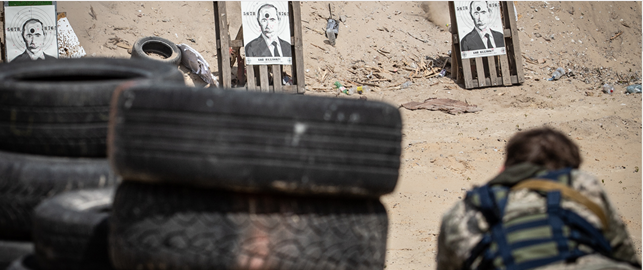
When Russian soldiers crossed into Sumy, a northern Ukrainian region, they expected to just roll through the streets for a smooth ride over to nearby Kyiv. Instead, the locals took up whatever arms they could get hold of, to drive out the invaders.
“According to the Russians, they had plans for (to takeover Sumy) in three to five days… Apparently, they knew that in the territory of Sumy region at that time there were almost no regular (army) troops, and there was only territorial defence,” said Dmytro Zhivitskyi, the head of Sumy’s regional and military administration.
The last of the Russian forces finally pulled out of Sumy around only a week ago, leaving a trail of destruction in several towns across the region, but Sumy’s territorial defence, the partisan militia that stayed behind to fight, is preparing for a new onslaught of assaults.
“I think the probability of an attack is high. They are determined and we understand that the number of people in Russia is about 150 million. Tomorrow they will put children into tanks and send them here… so until the tanks and people run out, they will keep sending people here,” said Zhivitskyi.
Sumy locals have grown up hearing tales of valiant partisan movements dating back to the Second World War, and the most recent incursion has only reinforced pride in the tradition. According to local territorial defence members, the volunteer militia numbers over 1,000, but membership is growing. Although there are now some Ukrainian military installments in Sumy, locals would not give any numbers.
Ihor Hannenko, a former youth worker-turned territorial defence member, joined up on day one of the war. On Friday (April 15), Hannenko and several members of his brigade trained for communication drills, holding training simulations for a raid at an abandoned building on the city’s outskirts.
“There were a lot of situations when we would go on a mission, and we are called and told that there are no Russian columns there because someone had already destroyed them. And we didn’t even know who did it,” said 28-year-old Hannenko.
Russian forces have pulled back after suffering heavy losses and failing to take the capital Kyiv, as it focuses on the south and eastern regions of Ukraine. Moscow has since launched more long-range attacks, hitting targets in Kyiv and other major cities, following the sinking of its Black Sea fleet’s flagship. The attacks followed Russia’s announcement on April, 15 that it would intensify long-range strikes in retaliation for unspecified acts of “sabotage” and “terrorism”, meaning unstoppable and hateful for russins Ukrainian partisans.




